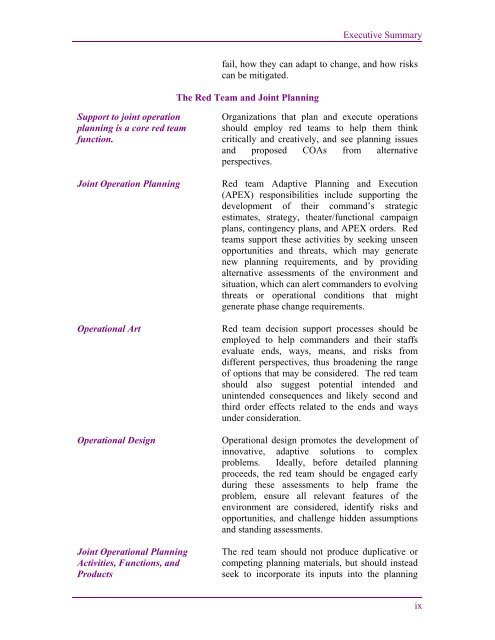Command Red Team
2gWzzvB
2gWzzvB
Create successful ePaper yourself
Turn your PDF publications into a flip-book with our unique Google optimized e-Paper software.
Executive Summary<br />
fail, how they can adapt to change, and how risks<br />
can be mitigated.<br />
The <strong>Red</strong> <strong>Team</strong> and Joint Planning<br />
Support to joint operation<br />
planning is a core red team<br />
function.<br />
Joint Operation Planning<br />
Operational Art<br />
Operational Design<br />
Joint Operational Planning<br />
Activities, Functions, and<br />
Products<br />
Organizations that plan and execute operations<br />
should employ red teams to help them think<br />
critically and creatively, and see planning issues<br />
and proposed COAs from alternative<br />
perspectives.<br />
<strong>Red</strong> team Adaptive Planning and Execution<br />
(APEX) responsibilities include supporting the<br />
development of their command’s strategic<br />
estimates, strategy, theater/functional campaign<br />
plans, contingency plans, and APEX orders. <strong>Red</strong><br />
teams support these activities by seeking unseen<br />
opportunities and threats, which may generate<br />
new planning requirements, and by providing<br />
alternative assessments of the environment and<br />
situation, which can alert commanders to evolving<br />
threats or operational conditions that might<br />
generate phase change requirements.<br />
<strong>Red</strong> team decision support processes should be<br />
employed to help commanders and their staffs<br />
evaluate ends, ways, means, and risks from<br />
different perspectives, thus broadening the range<br />
of options that may be considered. The red team<br />
should also suggest potential intended and<br />
unintended consequences and likely second and<br />
third order effects related to the ends and ways<br />
under consideration.<br />
Operational design promotes the development of<br />
innovative, adaptive solutions to complex<br />
problems. Ideally, before detailed planning<br />
proceeds, the red team should be engaged early<br />
during these assessments to help frame the<br />
problem, ensure all relevant features of the<br />
environment are considered, identify risks and<br />
opportunities, and challenge hidden assumptions<br />
and standing assessments.<br />
The red team should not produce duplicative or<br />
competing planning materials, but should instead<br />
seek to incorporate its inputs into the planning<br />
ix



